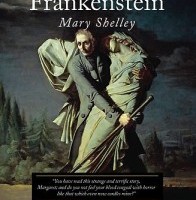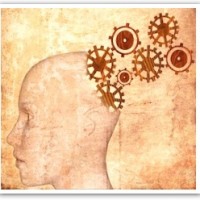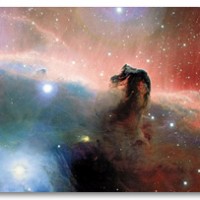Frankenstein: Prometheus Mythic & Modern, by Sean Fitzpatrick
The womb and the tomb—one of the most striking mirror images that our lives have to offer. Babies are buried alive in their warm mothers’ girth. Bodies are dead and buried in their cold mother earth. For one, there is the darkness of genesis and growth, for the other, the darkness of death and decay. The former are born to live for a span; the latter will be reborn to live for an eternity.
This pregnant parallel has been given immortal imagery in Mary Shelley’s Frankenstein; or, The Modern Prometheus. The mythic Prometheus is famous for creating men. The modern Prometheus is infamous for creating monsters. Both are tormented as a result of their creations, punished for the prideful usurping of a creative power that ultimately renders their creation deficient. The mythic Prometheus suffers for defying the supernatural, the modern Prometheus for defying the natural.
On what wings dare he aspire? What the hand, dare seize the fire?William Blake’s poem, “The Tyger,” instigates a dark literary trend of creature questioning and creator cursing, whose questions and curses are echoed by Milton’s Adam, and again by Shelley’s demon. For all of its modern connotations, however, Frankenstein represents an old story of creature rebellion. These rebellions had their birth with Lucifer’s “Non serviam,” and continue to rage with every fit of fallen nature and every man-made object that enslaves man. Victor Frankenstein is both rebel and victim of rebellion, as he turns his back on the order of things, forging into territory reserved for gods, only to be beset by the monstrous offspring of his sin. And as a monster, the creature is very much made in the image and likeness of his creator.
The story of Frankenstein is the quintessential mad scientist story, given immortal voice by Colin Clive in the 1931 film with his unforgettable, “It’s alive!” The story is, without doubt, alive—infused with life by the prevalent failure to recognize and respect the world’s sacrosanct and secret powers. Frankenstein and his monster stand as truly horrifying cultural icons of an enlightened era devoted more to science than to art. It has been said that the opposite of art is science. Art has everything to do with emotion, inspiration, and sacred mysteries. Science has nothing to do with any of these things, dealing instead with comprehension, investigation, and material calculations. As art can perfect nature, so science can pervert nature.
Read the complete article in The Imaginative Conservative
Neuroscience wants to be the answer to everything. It isn’t., by Roger Scruton
There are many reasons for believing the brain is the seat of consciousness. Damage to the brain disrupts our mental processes; specific parts of the brain seem connected to specific mental capacities; and the nervous system, to which we owe movement, perception, sensation and bodily awareness, is a tangled mass of pathways, all of which end in the brain. This much was obvious to Hippocrates. Even Descartes, who believed in a radical divide between soul and body, acknowledged the special role of the brain in tying them together.
The discovery of brain imaging techniques has given rise to the belief that we can look at people’s thoughts and feelings, and see how ‘information’ is ‘processed’ in the head. The brain is seen as a computer, ‘hardwired’ by evolution to deal with the long vanished problems of our hunter-gatherer ancestors, and operating in ways that are more transparent to the person with the scanner than to the person being scanned. Our own way of understanding ourselves must therefore be replaced by neuroscience, which rejects the whole enterprise of a specifically ‘humane’ understanding of the human condition.
In 1986 Patricia Churchland published Neurophilosophy, arguing that the questions that had been discussed to no effect by philosophers over many centuries would be solved once they were rephrased as questions of neuroscience. This was the first major outbreak of a new academic disease, which one might call ‘neuroenvy’. If philosophy could be replaced by neuroscience, why not the rest of the humanities, which had been wallowing in a methodless swamp for far too long? Old disciplines that relied on critical judgment and cultural immersion could be given a scientific gloss when rebranded as ‘neuroethics’, ‘neuroaesthetics’, ‘neuromusicology’, ‘neurotheology’, or ‘neuroarthistory’ (subject of a book by John Onians). Michael Gazzaniga’s influential study, The Ethical Brain, of 2005, has given rise to ‘Law and Neuroscience’ as an academic discipline, combining legal reasoning and brain imagining, largely to the detriment of our old ideas of responsibility. One by one, real but non-scientific disciplines are being rebranded as infant sciences, even though the only science involved has as yet little or nothing to say about them.
Read the complete article in CERC.
When Pigs Fly and Monkeys Type, by Gerald Schroeder.
Stephen Hawking in his A Brief History Of Time taught the world that given enough time, monkeys hammering away on typewriters could type out a Shakespeare sonnet.
It is a nice adage but totally off base, at least within the reality of our world. Having gone to MIT I don’t know many sonnets. In fact when I thought about this I only knew the opening line of one, “Shall I compare thee to a summer’s day.” There are a bit fewer than 500 letters in that sonnet [All Shakespeare's sonnets are about the same length; all by definition 14 lines long.]
Let’s consider a grab bag with the 26 letters of the English language in it. I reach into the bag blindfolded and pull out a letter. The likelihood that it will be ‘s’ for the first letter of the sonnet is one chance in 26. The likelihood that in two draws I will get an ‘s’ and then an ‘h’ is one chance in 26 times 26. And so on for the 500 letters. Neglecting spaces between the words, the chance of getting the entire sonnet by chance is 26 multiplied by itself 500 times. That number comes out to be a one with 700 zeroes after it. In conventional math terms, it is 10 to the exponent power of 700.
To give a sense of scale for reference, the known universe including dark matter and black energy weighs in the order of 10 to the power 56 grams; the number of basic particles [protons, neutrons, electrons, mesons] in the known universe is 10 to the power 80; the age of the universe from our perspective of time, 10 to the power 18 seconds. Convert all the universe into micro-computers each weighing a billionth of a gram and run each of those computers billions of times a second non-stop from the beginning of time and we still will need greater than 10 to the power 500 universes, or that much more time for even a remote probability of getting a sonnet; any meaningful sonnet. Chance does not produce intelligible text and certainly not a sonnet, not in our universe.
But so convincing is the Hawking argument that the students at the Plymouth University in England convinced the National Arts Council to put up 1500 Sterling, about $3000, to try monkey typing skills. They rented a monkey house for a month. Six monkeys hammered away on a computer key board and failed to produce a single English word. Surprised, since the shortest word in the English language is one letter long? Surely the monkeys must have hit an ‘A’ or an ‘I’ in all their efforts. But think about it. To a make an ‘A’ a word requires a space on each side of the ‘A’. That means typing: space, ‘A,’ space. If there are about 100 keys on the computer key board, the probability is one chance in a 100 times 100 times 100 which comes out to be one chance in a million. Random guessing in a spelling bee is always a losing proposition. And that is for a single letter word.
But what about life? Could random mutations have actually produced the ordered complexity of life, or even a viable protein? Mutations that are to be passed on to the next generation must occur in the genetic material of the reproductive line, which is in the DNA of sperm or egg. That mutation results in a variant (mutated) protein which might produce a new more effective type of organ, say a better muscle or the beginning of a transition from fin to foot. That would be the neo-Darwinian concept. But let’s look at that process rigorously. When we do we’ll see it does not work if randomness is the only driving force.
Read complete article in Catholic Education Resource Center.


